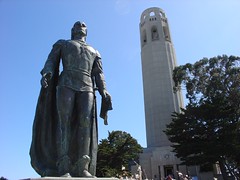World Book's latest edition says this about our erstwhile hero, known in Spain as Cristobal Colon:
Recent research into the life and times of Christopher Columbus has somewhat diminished his heroic image as an isolated visionary by placing him in the context of a broad wave of exploration. Historians continue to praise his persistence, courage, and maritime ability. Critics point to his cruelty to the Indians, his poor administration of Hispaniola, and his role in beginning the heedless exploitation of the natural resources of the Americas. Columbus's explorations ended centuries of mutual ignorance about what lay on either side of the Atlantic Ocean. To him belong both the glory of the encounter and a share of the blame for what followed.
One of the Columbus factors I enjoy considering:
The Americas provided foods that became popular throughout the world. These foods included cassava, cayenne, chocolate, hot peppers, paprika, peanuts, sweet potatoes, tomatoes, and white potatoes. Europe and Asia, in exchange, supplied the Americas with cattle, goats, honey bees, horses, pigs, rice, sheep, wheat, and many trees and other plants.
World Book also sees this big picture:
Many exchanges took place between the Eastern and Western hemispheres as a result of Columbus's voyages. The Europeans grew important cash crops-cotton, rubber, and sugar cane-in the Americas. They established vast plantations worked by Indians and by imported African slaves. They also obtained furs and precious metals. These valuable resources created fortunes for the Dutch, English, French, Portuguese, Russians, and Spanish. The wealth and human resources of the Western Hemisphere gave these countries a huge advantage over the rest of the world in later centuries.
* Columbus' home nation? Italy
* Columbus' adopted nation? Spain
* Location of his first landfall in the New World: a) Bahamas b) Florida c) Puerto Rico d) Jamaica.
answer: Bahamas, San Salvador Island.
Fourteen year-olds can write? One of the best chronicles of Columbus' voyages was written by his son Diego, age 14, who accompanied his dad on the fourth crossing, says WB.
Diego's chronicle is coinsidered a Primary Document. It is writing by a person who experienced the incident. Another example of a primary source: a journal or a ship's log. To read the Diego Columbus primary document I would have to know Spanish, learn ancient Spanish and travel to Madrid to read the parchment.
In our class we deal with secondary documents. These are works written about the incident by a journalist or historian who gathered the material from people who witnessed the incidents.
Independent work: research and compare the bios of Columbus and Albert Einstein.
Subscribe to:
Post Comments (Atom)


No comments:
Post a Comment